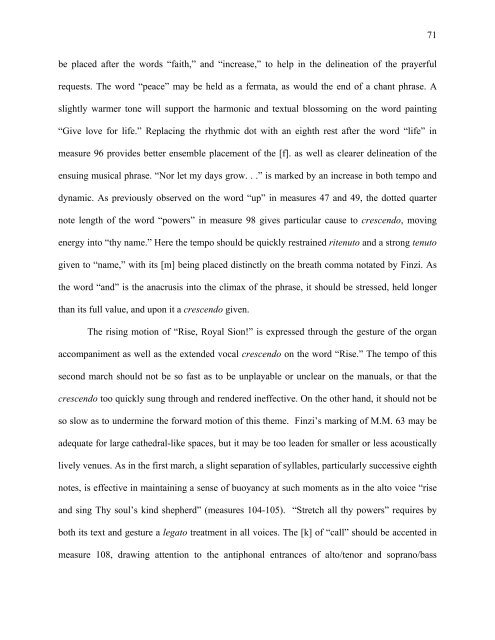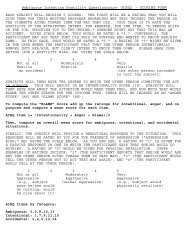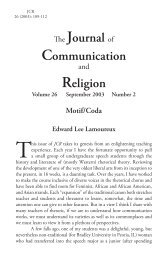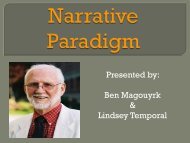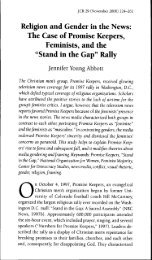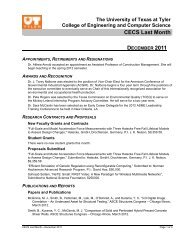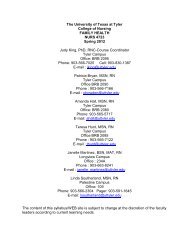71be placed after the words “faith,” <strong>and</strong> “increase,” to help in the delineation <strong>of</strong> the prayerfulrequests. The word “peace” may be held as a fermata, as would the end <strong>of</strong> a chant phrase. Aslightly warmer tone will support the harmonic <strong>and</strong> textual blossoming on the word painting“Give love for life.” Replacing the rhythmic dot with an eighth rest after the word “life” inmeasure 96 provides better ensemble placement <strong>of</strong> the [f]. as well as clearer delineation <strong>of</strong> theensuing musical phrase. “Nor let my days grow. . .” is marked by an increase in both tempo <strong>and</strong>dynamic. As previously observed on the word “up” in measures 47 <strong>and</strong> 49, the dotted quarternote length <strong>of</strong> the word “powers” in measure 98 gives particular cause to crescendo, movingenergy into “thy name.” Here the tempo should be quickly restrained ritenuto <strong>and</strong> a strong tenutogiven to “name,” with its [m] being placed distinctly on the breath comma notated by Finzi. Asthe word “<strong>and</strong>” is the anacrusis into the climax <strong>of</strong> the phrase, it should be stressed, held longerthan its full value, <strong>and</strong> upon it a crescendo given.The rising motion <strong>of</strong> “Rise, Royal Sion!” is expressed through the gesture <strong>of</strong> the organaccompaniment as well as the extended vocal crescendo on the word “Rise.” The tempo <strong>of</strong> thissecond march should not be so fast as to be unplayable or unclear on the manuals, or that thecrescendo too quickly sung through <strong>and</strong> rendered ineffective. On the other h<strong>and</strong>, it should not beso slow as to undermine the forward motion <strong>of</strong> this theme. Finzi’s marking <strong>of</strong> M.M. 63 may beadequate for large cathedral-like spaces, but it may be too leaden for smaller or less acousticallylively venues. As in the first march, a slight separation <strong>of</strong> syllables, particularly successive eighthnotes, is effective in maintaining a sense <strong>of</strong> buoyancy at such moments as in the alto voice “rise<strong>and</strong> sing Thy soul’s kind shepherd” (measures 104-105). “Stretch all thy powers” requires byboth its text <strong>and</strong> gesture a legato treatment in all voices. The [k] <strong>of</strong> “call” should be accented inmeasure 108, drawing attention to the antiphonal entrances <strong>of</strong> alto/tenor <strong>and</strong> soprano/bass
72pairings. A lift at the end <strong>of</strong> that same measure should be given to the alto voice, re-accentuatingthe repetition <strong>of</strong> the text in the following measure. An eighth rest should also be given to allvoice parts at the end <strong>of</strong> measure 109, just prior to the soprano/tenor “Harps,” also supporting theseparation <strong>of</strong> musical phrases. The antiphonal nature <strong>of</strong> the “Harps” entrances should beemphasized, as both are set by Finzi squarely <strong>and</strong> decisively one full beat apart. A moltocrescendo should take place on the half note “man” in measure 111, bringing us to the climax <strong>of</strong>the anthem in the ensuing phrase, “This sovereign subject.” Each note <strong>of</strong> this dramatic lineshould be fully accentuated as indicated by Finzi. The placement <strong>of</strong> [v] in “above” should bedistinct <strong>and</strong> voiced clearly on the second beat (tied sixteenth note) <strong>of</strong> measure 113. The words“The best am-” should function as unstressed upbeats into the syllable “bi-” which should beweighted heavily, with the final syllable, “-tion,” an unstressed schwa [ə]. A slight ritard<strong>and</strong>omay again be employed at the phrase ending “<strong>of</strong> thy,” before returning to original march tempoon the word “love” in measure 114.Theme j, “Lo, the Bread <strong>of</strong> Life,” is a triumphant fanfare, <strong>and</strong> as such, articulation shouldbe largely detached. Rhythms should be marked <strong>and</strong> declamatory, perhaps even to the point <strong>of</strong>over-dotting. Lifts to articulate the text <strong>and</strong> word-ending consonants should be placed after“Life” in measure 116, <strong>and</strong> “Text” in measure 118. The short but dramatic crescendo indicatedon “provokes thy” should be heightened, as the note value <strong>of</strong> “-vokes” is specifically extendedby Finzi to enable this treatment, literally invoking the fortissimo on “praise” in measures 119-120. The “r” <strong>of</strong> this word should be flipped or tapped [ɾ], avoiding at all costs the unsuitableAmerican hard or swallowed [r]. In measure 121-122, word stresses on “liv-ing,” “life,” <strong>and</strong>“bread” should be particularly asserted, as also “great,” “twelve” <strong>and</strong> “dis-tri-buted.” A quick liftbetween “bread” <strong>and</strong> “To the” provides more accurate placement <strong>of</strong> the [d], <strong>and</strong> a distinct point
- Page 1 and 2:
HISTORY, ANALYSIS AND PERFORMANCECO
- Page 3 and 4:
. . . as surely as birds must sing,
- Page 5:
LIST OF FIGURESFigurePage1. Constru
- Page 8 and 9:
LIST OF TABLESTablePage1. Section A
- Page 10 and 11:
HISTORICAL OVERVIEWIt was the summe
- Page 12 and 13:
3Hussey suggested a Eucharist theme
- Page 14 and 15:
Lo, the Full Final Sacrifice was at
- Page 16 and 17:
7miniaturist is now generally recog
- Page 18 and 19:
9Hardy (agnostic fatalist), Wordswo
- Page 20 and 21:
11According to Christopher, his fat
- Page 23:
14Examination of FormSection AThe a
- Page 26 and 27:
17However the arrival of A major at
- Page 28 and 29:
19Figure 7. Reduction of measures 1
- Page 30 and 31: 21Stanford, being of his generation
- Page 32 and 33: 23unique contour of these lines, a
- Page 34 and 35: 25Figure 12. Rising major third key
- Page 36 and 37: 27with the downward leap of a minor
- Page 38 and 39: 29Figure 15. “O Let that love”
- Page 40 and 41: Figure 16. “Jesu Master” organ
- Page 42 and 43: 33Crashaw’s images of “Food”
- Page 44 and 45: 35Harmony then, falls among every o
- Page 46 and 47: 37Section CAn immediate resetting o
- Page 48 and 49: Figure 21. “Weeping” organ gest
- Page 50 and 51: 41another shortened verse and fitti
- Page 52 and 53: 43unison/octaves. The preceding org
- Page 54 and 55: 45Figure 28. “Stretch all thy pow
- Page 56 and 57: 47Arriving at the word “love” a
- Page 58 and 59: 49agogic stresses to achieve a fitt
- Page 60 and 61: 51Table 4Section D - Thematic Struc
- Page 62 and 63: 53famine, feeding its young with it
- Page 64 and 65: 55global humanity en masse, but mor
- Page 66 and 67: 57Figure 37. “And that long day
- Page 68 and 69: 59Figure 39. Reduction of Section B
- Page 70 and 71: 61sublime heavenly and musical asce
- Page 73 and 74: PERFORMANCE CONSIDERATIONSPrinciple
- Page 75 and 76: 66and 16 to clarify structural punc
- Page 77 and 78: 68To add further contrast with the
- Page 79: 70breath in the vocal part to compl
- Page 83 and 84: 74for the tenor soloist be placed a
- Page 85 and 86: 76the word “chase” followed by
- Page 87 and 88: 78Finzi always had a sense that he
- Page 89 and 90: 808 Lo the Bread of Life, this day
- Page 91 and 92: 82_____ . The Composer’s Use of W


